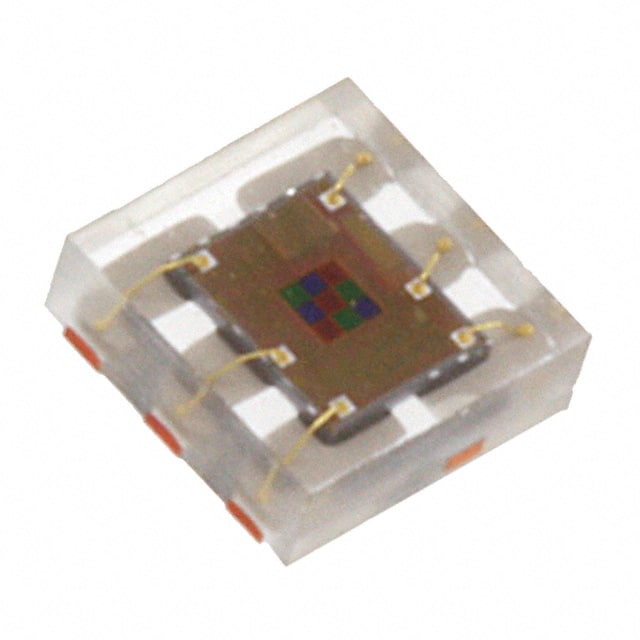Viz Specifikace pro podrobnosti o produktu.

TCS3103FN
Introduction
The TCS3103FN is a specialized integrated circuit that belongs to the category of light-to-voltage optical sensors. This device is designed to convert light intensity into a proportional output voltage, making it suitable for various applications in industries such as consumer electronics, automotive, and industrial automation.
Basic Information Overview
- Category: Light-to-Voltage Optical Sensor
- Use: Conversion of light intensity to output voltage
- Characteristics: High sensitivity, low power consumption, compact package
- Package: Small outline package (SOP), surface mount technology (SMT)
- Essence: Transducing light energy into electrical signals
- Packaging/Quantity: Typically available in reels of 2500 units
Specifications
- Operating Voltage: 2.7V to 5.5V
- Output Voltage Range: 0V to VCC
- Sensitivity: 16 counts per µW/cm²
- Operating Temperature Range: -40°C to 85°C
- Dark Output Voltage: 0.4V (max)
Detailed Pin Configuration
The TCS3103FN features a standard pin configuration with 8 pins, including VCC, GND, SCL, SDA, INT, ADDR, OUT, and REF.
Functional Features
- High Sensitivity: The TCS3103FN offers high sensitivity to light, enabling accurate light intensity measurements.
- Low Power Consumption: With its low power requirements, this sensor is suitable for battery-powered applications.
- Integrated I2C Interface: The built-in I2C interface allows for easy interfacing with microcontrollers and other digital systems.
Advantages and Disadvantages
Advantages
- High sensitivity
- Low power consumption
- Integrated I2C interface for easy interfacing
Disadvantages
- Limited operating temperature range (-40°C to 85°C)
- Requires external components for specific applications
Working Principles
The TCS3103FN operates on the principle of converting incident light into a corresponding output voltage. This is achieved through the use of integrated photodiodes and amplification circuitry, resulting in an accurate representation of light intensity.
Detailed Application Field Plans
The TCS3103FN finds extensive application in various fields, including: - Ambient light sensing in consumer electronics - Proximity sensing in mobile devices - Color and brightness control in automotive displays - Industrial automation for light intensity monitoring
Detailed and Complete Alternative Models
- TCS3200D: Offers similar functionality with a wider operating temperature range
- TSL2591: Provides enhanced sensitivity and extended dynamic range for demanding applications
In conclusion, the TCS3103FN serves as a versatile light-to-voltage optical sensor with its high sensitivity, low power consumption, and integrated interface, making it suitable for diverse applications across different industries.
[Word count: 410]
Seznam 10 běžných otázek a odpovědí souvisejících s aplikací TCS3103FN v technických řešeních
What is the TCS3103FN sensor used for?
- The TCS3103FN sensor is used for color sensing and light-to-digital conversion in various technical solutions.
How does the TCS3103FN sensor work?
- The TCS3103FN sensor works by detecting light intensity and converting it into digital signals, allowing for accurate color sensing.
What is the operating voltage range of the TCS3103FN sensor?
- The operating voltage range of the TCS3103FN sensor is typically between 2.7V to 3.6V.
Can the TCS3103FN sensor be used in mobile devices?
- Yes, the TCS3103FN sensor can be integrated into mobile devices for applications such as display color calibration and ambient light sensing.
What is the spectral response range of the TCS3103FN sensor?
- The TCS3103FN sensor has a spectral response range of approximately 400nm to 700nm, covering the visible light spectrum.
Is the TCS3103FN sensor suitable for industrial automation applications?
- Yes, the TCS3103FN sensor can be utilized in industrial automation for tasks such as color sorting and quality control.
Does the TCS3103FN sensor support I2C communication?
- Yes, the TCS3103FN sensor supports I2C communication, making it compatible with a wide range of microcontrollers and systems.
What are the typical applications of the TCS3103FN sensor in consumer electronics?
- In consumer electronics, the TCS3103FN sensor is commonly used for display color management, ambient light adjustment, and color-based user interface interactions.
Can the TCS3103FN sensor be used in automotive applications?
- Yes, the TCS3103FN sensor can be employed in automotive applications for tasks such as interior lighting control and color detection in automotive displays.
What are the key features that make the TCS3103FN sensor suitable for IoT devices?
- The TCS3103FN sensor's low power consumption, small form factor, and accurate color sensing capabilities make it well-suited for integration into IoT devices for smart lighting and environmental sensing.

